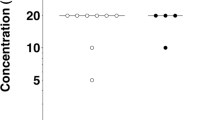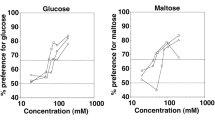Abstract
Mice of the 129/J (129) and C57BL/6ByJ (B6) strains and their reciprocal F1 and F2 hybrids were offered solutions of ethanol, sucrose, citric acid, quinine hydrochloride, and NaCl in two-bottle choice tests. Consistent with earlier work, the B6 mice drank more ethanol, sucrose, citric acid, and quinine hydrochloride solution and less NaCl solution than did 129 mice. Analyses of each generation's means and distributions showed that intakes of ethanol, quinine, sucrose, and NaCl were influenced by a few genes. The mode of inheritance was additive in the case of ethanol and quinine, for sucrose the genotype of the 129 strain was recessive, and for NaCl it was dominant. Citric acid intake appeared to be influenced by many genes with small effects, with the 129 genotype dominant. Correlations of sucrose consumption with ethanol and citric acid consumption were found among mice of the F2 generation, and the genetically determined component of these correlations was stronger than the component related to environmental factors. The genetically determined correlation between sucrose and ethanol intakes is consistent with the hypothesis that the higher ethanol intake by B6 mice depends, in part, on higher hedonic attractiveness of its sweet taste component.
Similar content being viewed by others
References
Azen, E. A. (1988). Linkage studies of genes for salivary proline-rich proteins and bitter taste in mouse and human. In Wysocki, C. J., and Kare, M. R. (eds.),Chemical Senses, Vol. 3: Genetics of Perception and Communication, Marcel Dekker, New York, pp. 279–290.
Bachmanov, A. A., and Dmitriev, Yu. S. (1992a). Genetic analysis of some behavioral and physiological traits in hybrids between hypertensive and normotensive rats: Analysis of the inheritance nature.Genetika 28:150–159 (in Russian).
Bachmanov, A. A., and Dmitriev, Yu. S. (1992b). Genetic analysis of some behavioral and physiological traits in hybrids between hypertensive and normotensive rats: Analysis of reciprocal differences.Genetika 28:120–127 (in Russian).
Bachmanov, A. A., Tordoff, M. G., and Beauchamp, G. K. (1994). Strain differences in salt appetite in mice.Abstracts of the 2nd Independent Meeting of the SSIB (Hamilton, Canada), A-24.
Bachmanov, A. A., Tordoff, M. G., and Beauchamp, G. K. (1996). Ethanol consumption and taste preferences in C57BL/6ByJ and 129/J mice.Alcohol Clin. Exp. Res. 20:201–206.
Ball, D. M., and Murray, R. M. (1994). Genetics of alcohol misuse.Br. Med. Bull. 50:18–35.
Beauchamp, G. K., and Fisher, A. S. (1993). Strain differences in consumption of saline solutions by mice.Physiol. Behav. 54:179–184.
Belknap, J. K., Crabbe, J. C., Plomin, R., McClearn, G. E., Sampson, K. E., O'Toole, L. A., and Gora-Maslak, G. (1992). Single-locus control of saccharin intake in BXD/Ty recombinant inbred (RI) mice: Some methodological implications for RI-strain analysis.Behav. Genet. 22:81–100.
Belknap, J. K., Crabbe, J. C., and Young, E. R. (1993). Voluntary consumption of ethanol in 15 inbred mouse strains,Psychopharmacology 112:503–510.
Boughter, J. D., Harder, D. B., Capeless, C. G., and Whitney, G. (1992). Polygenic determination of quinine aversion among mice.Chem. Senses 17:427–434.
Brewster, D. J. (1968). Genetic analysis of ethanol preference in rats selected for emotional reactivity.J. Hered. 59:283–286.
Capeless, C. G., and Whitney, G. (1995). The genetic basis of preference for sweet substances among inbred strains of mice: Preference ratio phenotypes and the alleles of theSac anddpa loci.Chem. Senses 20:291–298.
Capeless, C. G., Whitney, G., and Azen, E. A. (1992). Chromosome mapping ofSoa, a gene influencing gustatory sensitivity to sucrose octaacetate in mice.Behav. Genet. 22:655–663.
Collins, R. L. (1967). A general nomparametric theory of genetic analysis. I. Application to classical cross.Genetics 56:551.
Eriksson, K. (1971). Inheritance of behaviour towards alcohol in normal and motivated choice situations in mice.Ann. Zool. Fennici 8:400–405.
Falconer, D. S. (1989).Introduction to Quantitative Genetics, 3rd ed., J. Wiley & Sons, New York.
Fuller, J. L. (1964). Measurement of alcohol preference in genetic experiments.J. Comp. Physiol. Psychol. 57:85–88.
Fuller, J. L. (1974). Single-locus control of saccharin preference in mice.J. Hered. 65:33–36.
Fuller, J. L., and Collins, R. L. (1967). Ethanol preference in hybrids between a low and a high preference strain of mice.Genetics 56:560–561.
Fuller, J. L., and Collins, R. L. (1972). Ethanol consumption and preference in mice: A genetic analysis.Ann. N.Y. Acad. Sci. 197:42–48.
Gentry, R. T., and Dole, V. P. (1987). Why does a sucrose choice reduce the consumption of alcohol in C57BL/6J mice?Life Sci. 40:2191–2194.
Gilbertson, T. A., Gilbertson, D. M., Monroe, W. T., Milliet, J. R., and Caprio, J. (1995). Citrate enhances behavioral and cellular gustatory responses to sweet and amino acid stimuli in mammals. InAbstracts of the AChemS-XVII, April 1995 (Sarasota, Florida), p. 235.
Ginsburg, E. Kh., and Kulikov, A. V. (1983). Verification of monogenic hypotheses in the hybridological analysis of quantitative characters.Genetika 19:571–576 (in Russian).
Gora-Maslak, G., McClearn, G. E., Crabbe, J. C., Phillips, T. J., Belknap, J. K., and Plomin, R. (1991). Use of recombinant inbred strains to identify quantitative trait loci in psychopharmacology.Psychopharmacology 104:413–424.
Grupp, L. A., Perlanski, E., and Stewart, R. B. (1991). Regulation of alcohol consumption by the renin-angiotensin system: A review of recent findings and a possible mechanism of action.Neurosci. Biobehav. Rev. 15:265–275.
Hubell, C. L., Marglin, S. H., Spitalnic, S. J., Abelson, M. L., Wild, K. D., and Reid, L. D. (1991). Opioidergic, serotoninergic, and dopaminergic manipulations and rats' intake of a sweetened alcoholic beverage.Alcohol 8:355–367.
Jinks, J. L., and Broadhurst, P. L. (1974). How to analyse the inheritance of behaviour in animals—the biometrical approach. In van Abeelen, J. H. F. (ed.),The Genetics of Behaviour, North-Holland, Amsterdam, pp. 1–41.
Kiefer, S. W., and Lawrence, G. J. (1988). The sweet-bitter taste of alcohol: Aversion generalization to various sweet-quinine mixtures in the cat.Chem. Senses 13:633–641.
Komura, S., Ueda, M., and Kobayashi, T. (1972). Effects of foster nursing on alcohol selection in inbred strains of mice.Q. J. Stud. Alcohol. 33:494–503.
Lush, I. E. (1981). The genetics of tasting in mice. I. Sucrose octaacetate.Genet. Res. 44:151–160.
Lush, I. E. (1984). The genetics of tasting in mice. III. Quinine.Genet. Res. 44:151–160.
Lush, I. E. (1989). The genetics of tasting in mice. VI. Saccharin, acesulfame, dulcin and sucrose.Genet. Res. 53:95–99.
Lush, I. E. (1991). The genetics of bitterness, sweetness, and saltiness in strains of mice. In Wysocki, C. J., and Kare, M. R. (eds.),Chemical Senses, Vol. 3: Genetics of Perception and Communication, Marcel Dekker, New York, pp. 227–241.
MacLean, C. J., Morton, N. E., Elston, R. C., and Yee, S. (1976). Skewness in commingled distributions.Biometrics 32:695–699.
Mather, K., and Jinks, J. L. (1977).Introduction to Biometrical Genetics, Cornell University Press, New York.
McClearn, G. E., and Rodgers, D. (1961). Genetic factors in alcohol preference of laboratory mice.J. Comp. Physiol. Psychol. 54:116–119.
Nachman, M., Larue, C., and Le Magnen, J. (1971). The role of olfactory and orosensory factors in the alcohol preference of inbred strains of mice.Physiol. Behav. 6:53–95.
Ninomiya, Y., and Funakoshi, M. (1993). Genetic and neurobehavioral approaches to the taste receptor mechanism in mammals. In Simon, S. A., and Roper, S. O. (eds.),Mechanisms of Taste Transduction, CRC Press, Boca Raton, FL, pp. 253–272.
Ninomiya, Y., Higashi, T., Mizukoshi, T., and Funakoshi, M. (1987). Genetics of the ability to perceive sweetness of dphenylalanine in mice.Ann. N.Y. Acad. Sci. 510:527–529.
Overstreet, D. H., Kampov-Polevoy, A. B., Rezvani, A. H., Murelle, L., Halikas, J. A., and Janowsky, D. S. (1993). Saccharin intake predicts ethanol intake in genetically heterogeneous rats as well as different rat strains.Alcohol Clin. Exp. Res. 17:366–369.
Pelchat, M. L., and Danowski, S. (1992). A possible genetic association between PROP-tasting and alcoholism.Physiol. Behav. 51:1261–1266.
Pelz, W. E., Whitney, G., and Smith, J. C. (1973). Genetic influences on saccharin preference of mice.Physiol. Behav. 10:263–265.
Phillips, T. J., Crabbe, J. C., Metten, P., and Belknap, J. K. (1994). Localization of genes affecting alcohol drinking in mice.Alcohol Clin. Exp. Res. 18:931–941.
Pickett, R. A., and Collins, A. C. (1975). Use of genetic analysis to test the potential role of serotonin in alcohol preference.Life Sci. 17:1291–1296.
Price, R. A., Sorensen, T. I., and Stunkard, A. J. (1989). Component distributions of body mass index defining moderate and extreme overweight in Danish women and men.Am. J. Epidemiol. 130:193–201.
Pucilowski, O., Rezvani, A. H., and Jonowsky, D. S. (1992). Suppression of alcohol and saccharin preference in rats by a novel Ca2+ channel inhibitor, Goe 5438,Psychopharmacology 107:447–452.
Ramirez, I., and Fuller, J. L. (1976). Genetic influence on water and sweetened water consumption in mice.Physiol. Behav. 16:163–168.
Randall, C. L., and Lester, D. (1975). Cross-fostering of DBA and C57B1 mice: Increase in voluntary consumption of alcohol by DBA weanlings.J. Stud. Alcohol. 36:973–980.
Reed, D. R., Bartoshuk, L. M., Duffy, V., Marino, S., and Price, R. A. (1995). PROP tasting: Determination of underlying thresholds distributions using maximum likelihood.Chem. Senses 20:529–533.
Rodriguez, L. A., Plomin, R., Blizard, D. A., Jones, B. C., and McClearn, G. E. (1995). Alcohol acceptance, preference, and sensitivity in mice. II. Quantitative trait loci mapping analysis using BXD recombinant inbred strains.Alcohol Clin. Exp. Res. 19:367–373.
Sollars, S. I., Midkiff, E. E., and Bernstein, I. L. (1990). Genetic transmission of NaCl aversion in the Fisher-334 rat.Chem. Senses 15:521–527.
Stewart, R. B., Russell, R. N., Lumeng, L., Li, T.-K., and Murphy, J. M. (1994). Consumptions of sweet, salty, sour, and bitter solutions by selectively bred alcohol-preferring and alcohol-nonpreferring lines of rats.Alcohol Clin. Exp. Res. 18:375–381.
Stockton, M. D., and Whitney, G. (1974). Effects of genotype, sugar, and concentration on sugar preference of laboratory mice (Mus musculus).J. Comp. Physiol. Psychol. 86:62–68.
Thomas, K. (1969). Selection and avoidance of alcohol solutions by two strains of inbred mice and derived generations.Q. J. Stud. Alcohol 30:849–861.
Whitney, G., and Harder, D. B. (1994). Genetics of bitter perception in mice.Physiol. Behav. 56:1141–1147.
Author information
Authors and Affiliations
Corresponding author
Rights and permissions
About this article
Cite this article
Bachmanov, A.A., Reed, D.R., Tordoff, M.G. et al. Intake of ethanol, sodium chloride, sucrose, citric acid, and quinine hydrochloride solutions by mice: A genetic analysis. Behav Genet 26, 563–573 (1996). https://doi.org/10.1007/BF02361229
Received:
Accepted:
Issue Date:
DOI: https://doi.org/10.1007/BF02361229




